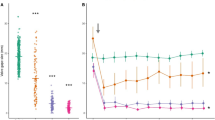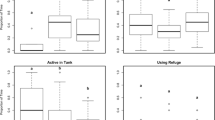Abstract
Hard clams, Mercenaria mercenaria, are sessile, filter-feeding organisms that are heavily preyed upon by blue crabs, which find their clam prey using chemical cues. Clams may evade blue crabs by reducing their pum** (feeding) behavior when a threat is perceived. The purpose of this study was to determine the type of signals that clams use to detect consumers. Clams decreased their pum** time in response to blue crabs and blue crab effluent, but not to crab shells, indicating that chemical signals and not mechanical cues mediated the response of clams to distant predators. Because predator diet can influence prey evaluation of predatory threats, we compared clam responses to blue crabs fed a steady diet of fish, clams, or that were starved prior to the experiment. In addition, we used injured clams as a stimulus because many organisms detect predators by sensing the odor of injured con- or heterospecifics. Clams reduced feeding in response to injured conspecifics and to blue crabs that had recently fed. Clams reacted similarly to fed crabs, regardless of their diet, but did not respond to starved blue crabs. Because blue crabs are generalist predators and the threat posed by these consumers is unrelated to the crab's diet, we should expect clam reactions to blue crabs to be independent of the crab's diet. The failure of clams to react to starved blue crabs likely increases their vulnerability to these consumers, but clam responses to injured conspecifics may constitute a strategy that allows animals to detect an imminent threat when signals emanating from blue crabs are not detectable.

Similar content being viewed by others
References
Aukema, B. H. and Raffa, K. F. 2004. Does aggregation benefit bark beetles by diluting predation? Links between a group-colonization strategy and the absence of emergent multiple predator effects. Ecol. Entomol. 29:129–138.
Brown, G. E. and Dreier, V. M. 2002. Predator inspection and attack cone avoidance in the characin fish: the effects of predator diet and prey experience. Anim. Behav. 63:1175–1181.
Brown, G. E., Paige, J. A., and Godin, J. G. J. 2000. Chemically mediated predator inspection behavior in the absence of predation visual cues by a characin fish. Anim. Behav. 60:315–321.
Bryer, P. J., Mirza, R. S., and Chivers D. P. 2001. Chemosensory assessment of predation risk by slimy sculpins, Cottus cognathus: Responses to alarm, disturbance, and predator cues. J. Chem. Ecol. 27:533–546.
Carpenter, S. R., Kitchell, J. F., and Hodgson, J. R. 1985. Cascading tropic interactions and lake productivity. BioScience 35:634–639.
Chivers, D. P. and Mirza, R. S. 2001. Importance of predator diet cues in responses of larval wood frogs to fish and invertebrate predators. J. Chem. Ecol. 27:45–51.
Chivers, D. P. and Smith, R. J. F. 1998. Chemical alarm signaling in aquatic predator–prey interactions: a review and prospectus. Ecoscience 5:338–352.
Chivers, D. P., Wisenden, B. D., and Smith R. J. F. 1996. Damselfly larvae learn to recognize predators from chemical cues in the predator's diet. Anim. Behav. 52:315–320.
Coen, L. D. and Heck, K. L., Jr. 1991. The interactive effects of siphon-nip** and habitat on bivalve (Mercenaria mercenaria (L.)) growth in a subtropical seagrass (Halodule wrightii Aschers) meadow. J. Exp. Mar. Biol. Ecol. 145:1–13.
Cote', I. M. and Jelnikar, E. 1999. Predator-induced clum** behavior in mussels (Mytilus edulis Linnaeus). J. Exp. Mar. Biol. Ecol. 235:201–211.
Crowl, T. A. and Covich, A. P. 1990. Predator-induced life history shifts in a freshwater snail. Science 247:949–951.
Eggleston, D. B., Lipcius, R. N., and Hines, A. H. 1992. Density-dependent predation by blue crabs upon infaunal clam species with contrasting distribution and abundance patters. Mar. Ecol., Prog. Ser. 85:55–68.
Ferner, M. C. and Weissburg, M. J. 2005. Slow-moving predatory gastropods track prey odors in fast and turbulent flow. J. Exp. Biol. 208:809–819.
Finelli, C. M., Pentcheff, N. D., Zimmer, R. K., and Wethey, D. S. 2000. Physical constraints on ecological process: a field test of odor-mediated foraging. Ecology 81:784–797.
Fitzgibbon, C. D. 1990. Mixed species grou** in Thompson's and Grant's gazelles: the antipredator benefits. Anim. Behav. 39:1116–1126.
Hamilton, W. D. 1971. Geometry for the selfish herd. J. Theor. Biol. 31:295–311.
Howe, N. R. and Harris, L. G. 1978. Transfer of the sea anemone pheromone, anthopluerine, by the nudibranch Aeolidia papillosa. J. Chem. Ecol. 4:551–561.
Irlandi, E. A. 1994. Large and small-scale effects of habitat structure on rates of predation: how percent coverage of seagrass affects rates of predation and siphon-nip** on an infaunal bivalve. Oecologia 98:176–183.
Irlandi, E. A. and Peterson, C. H. 1991. Modification of animal habitat by large plants: Mechanisms by which seagrasses influence clam growth. Oecologia 87:307–318.
Katz, L. B. and Dill, L. M. 1998. The scent of death: chemosensory assessment of predation risk by animals. Ecoscience 5:361–394.
Leonard, G. H., Bertness, M. D., and Yund, P. O. 1999. Crab predation, waterborne cues, and inducible defenses in blue mussels, Mytilus edulis. Ecology 80:1–14.
Lima, S. L. 1998. Nonlethal effects in the ecology of predator–prey interactions. BioScience 48:25–34.
Lima, S. L. 2002. Putting predators back into behavioral predator–prey interactions. Trends Ecol. Evol. 17:70–75.
Lima, S. L. and Dill, L. M. 1990. Behavioral decisions made under the risk of predation: A review and prospectus. Can. J. Zool. 68:619–640.
Mackie, A. M. and Shelton, R. G. J. 1972. A whole animal bioassay for the determination of food attractants of the lobster Homarus gammaus. Mar. Biol. 14:217–224.
Madison, D. M., Sullivan, A. M., Maerz, J. C., McDarby, J. H., and Rohr, J. R. 2002. A complex, cross-taxon, chemical releaser of antipredator behavior in amphibians. J. Chem. Ecol. 28:2271–2282.
Mathis, A. and Smith, R. J. F. 1993. Intraspecific and cross super-order responses to chemical alarm signals by brook stickleback. Ecology 74:2395–2404.
Menge, B. A. 2000. Top-down and bottom-up community regulation in marine rocky intertidal habitats. J. Exp. Mar. Biol. Ecol. 250:257–289.
McIntosh, A. R. and Peckarsky, B. L. 1999. Criteria determining behavioural responses to multiple predators by a stream mayfly. Oikos 85:554–564.
Micheli, F. 1995. Behavioural plasticity in prey-size selectivity of the blue crab Callinectes sapidus feeding on bivalve prey. J. Anim. Ecol. 64, 63–74.
Micheli, F. 1997. Effects of predator foraging behavior on patterns of prey mortality in marine soft bottoms. Ecol. Monogr. 67:203–224.
Millar, J. G. and Haynes, K. F. (eds.). 1998. Methods in Chemical Ecology, Volume 1: Chemical Methods. Kluwer Academic Publishers, Norwell, MA. 390 p.
Mirza, R. A. and Chivers, D. P. 2001. Do juvenile yellow perch use diet cues to assess the level of threat posed by intraspecific predators? Behaviour 138:1249–1258.
Nakaoka, M. 2000. Nonlethal effects of predators on prey populations: Predator-mediated change in bivalve growth. Ecology 81:1031–1045.
Paine, R. T. 1966. Food web complexity and species diversity. Am. Nat. 103:65–75.
Peckarsky, B. L. 1996. Alternative predator avoidance syndromes of stream-dwelling mayfly larvae. Ecology 77:1888–1905.
Peterson, C. H. 1986. Quantitative allometry of gamete production by Mercenaria mercenaria into old age. Mar Ecol., Prog. Ser. 29:93–97.
Petranka, J. W. and Hays, L. 1998. Chemically-mediated avoidance of a predatory odonate (Anax junius) by American toad (Bufo americanus) and wood frog (Rana sylvatica) tadpoles. Behav. Ecol. Sociobiol. 42:23–271.
Petranka, J. W., Katz, L. B., and Sih, A. 1987. Predator–prey interactions among fish and larval amphibians: use of chemical cues to detect predatory fish. Anim. Behav. 35:420–425.
Powell, G. V. N. 1974. Experimental analysis of the social value of flocking by starlings (Sturnus vulgaris) in relation to predation and foraging. Anim. Behav. 22:501–505.
Schmitz, O. J. 1998. Direct and indirect effects of predation and predation risk in old-field interaction webs. Am. Nat. 151:327–342.
Schmitz, O. J., Beckerman, A. P., and O'Brien, K. M. 1997. Behaviorally-mediated trophic cascades: Effects of predation risk on food web interactions. Ecology 78:1388–1399.
Sih, A., Crowley, P., McPeek, M., Petranka, J., and Strothmeier, K. 1985. Predation, competition, and prey communities: a review of field experiments. Ann. Rev. Ecolog. Syst. 16:269–312.
Smee, D. L. and Weissburg, M. J. In press. Clamming up: environmental forces diminish the perceptive ability of bivalve prey. Ecology.
Smith, M. E. and Belk, M. C. 2001. Risk assessment in western mosquitofish (Gambusia affinis): Do multiple cues have additive effects? Behav. Ecol. Sociobiol. 51:101–107.
Sokal, R. R. and Rohlf, F. J. 1995. Biometry: The Principles and Practice of Statistics in Biological Research. 3rd edition. W. H. Freeman and Co., New York.
Stabell, O. B. and Lwin, M. S. 1997. Predator-induced phenotypic changes in crucian carp are caused by chemical signals from conspecifics. Environ. Biol. Fisches 49:145–149.
Sullivan, K. A. 1984. The advantages of social foraging in downy woodpeckers. Anim. Behav. 32:16–22.
Virnstein, R. W. 1977. The importance of predation by crabs and fishes on benthic infauna in Chesapeake Bay. Ecology 58:1199–1217.
Walker, R. L. 1987. Hard clam, Mercenaria mercenaria (L.) populations of coastal Georgia. Georgia Marine Science Center, Technical Report Series 87-1, Athens.
Webster, D. R. and Weissburg, M. J. 2001. Chemosensory guidance cues in a turbulent odor plume. Limnol. Oceanogr. 46:1034–1047.
Weissburg, M. J. and Zimmer-Faust, R. K. 1993. Life and death in moving fluids: hydrodynamic effects on chemosensory mediated predation. Ecology 74:1428–1443.
Weissburg, M. J., Ferner, M. C., Pisut, D. P., and Smee, D. L. 2002. Ecological consequences of chemically mediated prey perception. J. Chem. Ecol. 28:1953–1970.
Werner, E. E. and Peacor, S. D. 2003. A review of trait-mediated indirect interactions in ecological communities. Ecology 84:1083–1100.
Zimmer, R. K. and Butman, C. A. 2000. Chemical signaling processes in the marine environment. Biol. Bull. 198:168–187.
Zimmer-Faust, R. K. and Case, J. F. 1982. Organization of food search in the kelp crab, Pugettia producta (Randall). J. Exp. Mar. Biol. Ecol. 57:237–255.
Acknowledgments
The authors thank S. Smee, L. Smee, and J. Jackson for help in collecting animals in the field and M. Ferner for maintaining the SkIO flume. Funding for this project came from the NSF IGERT grant to the Georgia Institute of Technology and NSF grant OCE #0424673 to MJW.
Author information
Authors and Affiliations
Corresponding author
About this article
Cite this article
Smee, D.L., Weissburg, M.J. Hard Clams (Mercenaria mercenaria) Evaluate Predation Risk Using Chemical Signals from Predators and Injured Conspecifics. J Chem Ecol 32, 605–619 (2006). https://doi.org/10.1007/s10886-005-9021-8
Received:
Revised:
Accepted:
Published:
Issue Date:
DOI: https://doi.org/10.1007/s10886-005-9021-8




